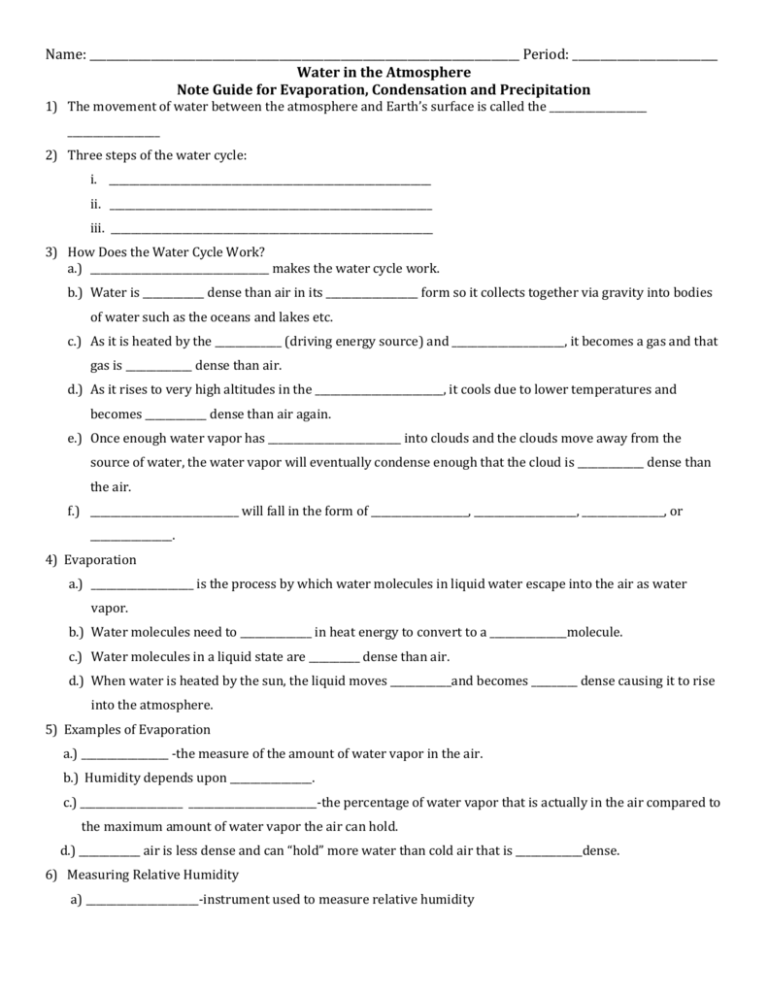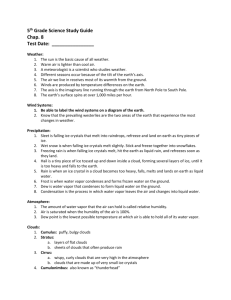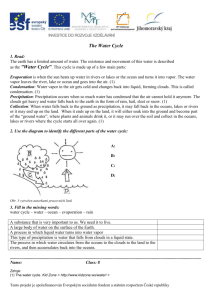Water in the Atmosphere Notes
advertisement

Name: _____________________________________________________________________________ Period: __________________________ Water in the Atmosphere Note Guide for Evaporation, Condensation and Precipitation 1) The movement of water between the atmosphere and Earth’s surface is called the ___________________ __________________ 2) Three steps of the water cycle: i. _______________________________________________________________ ii. _______________________________________________________________ iii. _______________________________________________________________ 3) How Does the Water Cycle Work? a.) ___________________________________ makes the water cycle work. b.) Water is ____________ dense than air in its __________________ form so it collects together via gravity into bodies of water such as the oceans and lakes etc. c.) As it is heated by the _____________ (driving energy source) and ______________________, it becomes a gas and that gas is _____________ dense than air. d.) As it rises to very high altitudes in the _________________________, it cools due to lower temperatures and becomes ____________ dense than air again. e.) Once enough water vapor has __________________________ into clouds and the clouds move away from the source of water, the water vapor will eventually condense enough that the cloud is _____________ dense than the air. f.) _____________________________ will fall in the form of ___________________, ____________________, ________________, or ________________. 4) Evaporation a.) ____________________ is the process by which water molecules in liquid water escape into the air as water vapor. b.) Water molecules need to ______________ in heat energy to convert to a _______________molecule. c.) Water molecules in a liquid state are __________ dense than air. d.) When water is heated by the sun, the liquid moves ____________and becomes _________ dense causing it to rise into the atmosphere. 5) Examples of Evaporation a.) _________________ -the measure of the amount of water vapor in the air. b.) Humidity depends upon ________________. c.) ____________________ _________________________-the percentage of water vapor that is actually in the air compared to the maximum amount of water vapor the air can hold. d.) ____________ air is less dense and can “hold” more water than cold air that is _____________dense. 6) Measuring Relative Humidity a) ______________________-instrument used to measure relative humidity b) Made of 2 thermometers i. ____________________ thermometer ii. ____________________ thermometer c) ____________________ thermometer-bulb has a cloth covering that is moistened with water. d) _____________________is spun by the handle and air blows over both thermometers. e) Wet-bulb thermometer is cooled by _________________. f) Compare readings on the two thermometers. 7) How to Determine Relative Humidity a) Measure the ____________________ temperature. b) Measure the ____________________ temperature. c) Calculate the _____________________ between the dry bulb and wet bulb temperatures. d) Find the ____________________ temperature on the table. e) Find the _____________________ between the wet and dry bulb temperatures on the table. f) The ________________ _________________ will be at the intersection of the row and column. 8) Relative Humidity Table Examples a) Suppose the relative humidity of the air is 51% and the reading of the dry-bulb thermometer is 200C. What is the reading of the wet-bulb thermometer? i. ____________________________ b) The readings on a sling psychrometer are 14 0C for the dry-bulb thermometer and 12 0C for the wet-bulb thermometer. What is the relative humidity? i. ____________________________ 9) Example of Evaporation a) _____________________ is your body’s natural way of cooling down. b) When sweat reaches the surface of our skin, it then ____________________, which cools us down! c) _______________ is transferred from your skin to the water which makes you feel cooler. d) __________________ ___________________: When you hang socks outside to dry, you're using ________________ from the Sun and the wind to ____________________ and disperse the water they contain. 10) Condensation a) As __________________, moist air rises in the atmosphere; its temperature begins to _________________. b) Molecules of water vapor in the air become liquid water in the process of ___________________. 11) How Clouds Form a) Clouds form when water vapor in the air ___________________to form liquid water or ice crystals. b) Two conditions required for condensation: i. _________________ of the air ii. Presence of_________________ in the air 12) The Role of Cooling a) _____________ air holds less water vapor than warm air. b) ___________ ____________-the temperature at which condensation begins. c) Dew point _____________ freezing=water vapor forms water droplets. d) Dew point ______________ freezing=water vapor may change into ice crystals. 13) Dew Point and Humidity a) The ___________ the dew point, the ____________ moisture in the air. i. Example: __________________________________________________________________________________ b) The ___________ the dew point, the ____________ moisture in the air. i. Example: __________________________________________________________________________________ 14) The Role of Particles a) For water vapor to _________________, tiny particles must be present so the water has a surface on which to condense. b) In ______________ formation, most of these particles are salt crystals, dust from soil, and smoke. c) Water vapor also condenses onto ____________ _____________, such as ______________ ____ ____________ or window panes. d) Liquid water that condenses from the air onto a cooler surface is called ________. e) Ice that has been deposited on a surface that is below freezing is called _____________. 15) Fog a) ________________ are classified by their shape and their altitude. b) Different types of clouds are associated with different types of _______________. c) Clouds that form at or near the ground are called __________. d) Fog often forms when the ground __________ at night after a warm, humid day. e) The ground cools the air just above the ground to the air’s __________ __________. f) The next day the heat of the morning sun __________ the fog off as its water droplets _____________. 16) Cloud Seeding a) During drought conditions, a method called ______________ ______________ is used to produce precipitation. b) Tiny crystals of ____________ _____________ and ____________ ____________ are sprinkled into clouds from airplanes. c) Water vapor can condense on the ________________ of silver iodide and dry ice ___________ the water vapor from the air. d) As a result, ______________ form. 17) Precipitation a) _________________ is any form of water that falls from clouds and reaches Earth’s surface. b) Not all clouds produce precipitation. c) For precipitation to occur, cloud droplets or ice crystals must grow _____________enough to fall through the air. 18) Types of Precipitation a) Common types of precipitation include: i. _________________________ ii. _________________________ iii. ________________________ iv. ________________________ v. ________________________ 19) Rain a) Most ____________ form of precipitation. b) Drops of water __________ in diameter. c) Drizzle-drops of water less than 0.5 mm. d) Mist- drops of water smaller than drizzle. 20) Sleet a) Raindrops fall through a layer of air that is below __________. b) Ice particles smaller than ___________ in diameter. 21) Freezing Rain a) Raindrops falling through cold air near the ground do not freeze in the air, instead they freeze on a _______________ _______________. 22) Snow a) Water vapor in a cloud that is converted directly to ice crystals is called a _______________. 23) Hail a) Round pellets of ice larger than __________ in diameter. b) Form during _______________________________ c) Difference between sleet and hail is the ____________ of the ice pellets and where the ice pellets _________________. 24) Measuring Precipitation a) _______________ _________________- open-ended can or tube that collects rainfall. i. the amount of rainfall is measured by dipping a ruler into the water or by reading a marked scale. b) ______________________ ___________________________









